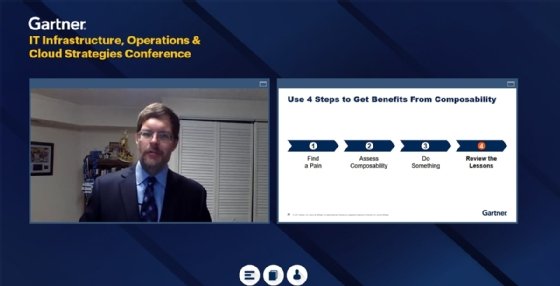
Getty Images/iStockphoto
Build on the Anywhere Operations trend with composability
The ability to access infrastructure remotely is crucial for IT organizations to meet business initiatives. Composable infrastructure is one way to support this model.
Before the COVID-19 pandemic, remote work was not unheard of, but now it's essential. However, it takes more than just shipping out laptops to employees to establish an Anywhere Operations model.
One way to successfully jump on the Anywhere Operations trend is to create a composable infrastructure.
"From an I&O perspective, [composability] is also going to help us to cope with this world of Anywhere Operations, where our infrastructure is everywhere -- it's in the cloud, it's at the edge, it's in our traditional data centers; our workers are dispersed all over the world," said Roger Williams, VP analyst at Gartner, in a presentation at the 2021 Gartner IT Infrastructure, Operations & Cloud Strategies Conference. "And our customers are in a lot of different environments [and] want to be able to access this when and where they choose. Our ability to cope with that requires composability in order for us to be successful."
Before we can get started with composability, we need to understand its core tenets. And once composability is in place, we need to evaluate it using the KALM approach.
What is composability?
Composability decouples device resources, such as physical compute and storage, to treat them as services. This infrastructure setup frees IT administrators from worrying about where components are physically located -- ideal for an Anywhere Operations structure.
Composability relies on four main principles:
- Modularity. Split a domain into specific pieces that can be scaled and controlled.
- Orchestration. Manage the interactions between these pieces to accomplish goals.
- Autonomy. Minimize component interdependency so that changes to a single piece do not affect others.
- Discovery. Find these pieces and others to streamline work.
With these four elements, IT teams can use composability to support the adoption of the Anywhere Operations trend.
How to get started
The first step to enable Anywhere Operations with composability is to find an area that lacks the flexibility or resiliency you need. This point of focus should ideally fit these characteristics:
- It matters -- ideally to someone outside of infrastructure and operations.
- The current implementation hurts the business.
- It appeals to the broader organization.
- It's the right time to take action.
Once a team picks its area of focus, then it must assess this issue against the core tenets of composability. For this assessment, pull in the right people to help, such as the architects who will work on the project or other key stakeholders.
Next, take action to correct the area that falls short. If the modularity is lacking, then an IT team might need to break down the complex entities and make inputs and outputs consistent. For orchestration problems, simplify workflows and adopt the right tools for the situation. To handle autonomy issues, separate resources and streamline the approval rules. If the issue lies with discovery, make popular items easier to find -- for example, use feature flags to make things stand out, or personalize portals.

Evaluate changes with the KALM approach
After you have made changes to a bottleneck, the next step is to review how it went. One way to do this is to use the KALM approach: Keep, Add, Less, More.
This approach requires asking four questions:
- What do we want to keep that adds value? To answer this question, look at the tools and practices already in place that add value to your organization.
- What do we still need to add? The answer is whatever you found that was missing or would have been helpful. For example, tools or techniques your organization would like to try in the future to help address this issue.
- Is there something we can do less of? This can mean reevaluating tools you thought you would use but didn't. It can also mean assessing the activities that turned staff off from the work. Make note of this for any future iterations.
- What can we do more of? The answer to this question lies in the 80/20 rule, which asks what the 20% action was that yielded 80% of the benefit, and how to get more out of these actions in the future.
Answering these questions in a review will help guide an organization on how to use composability so that it can jump on the Anywhere Operations trend.






